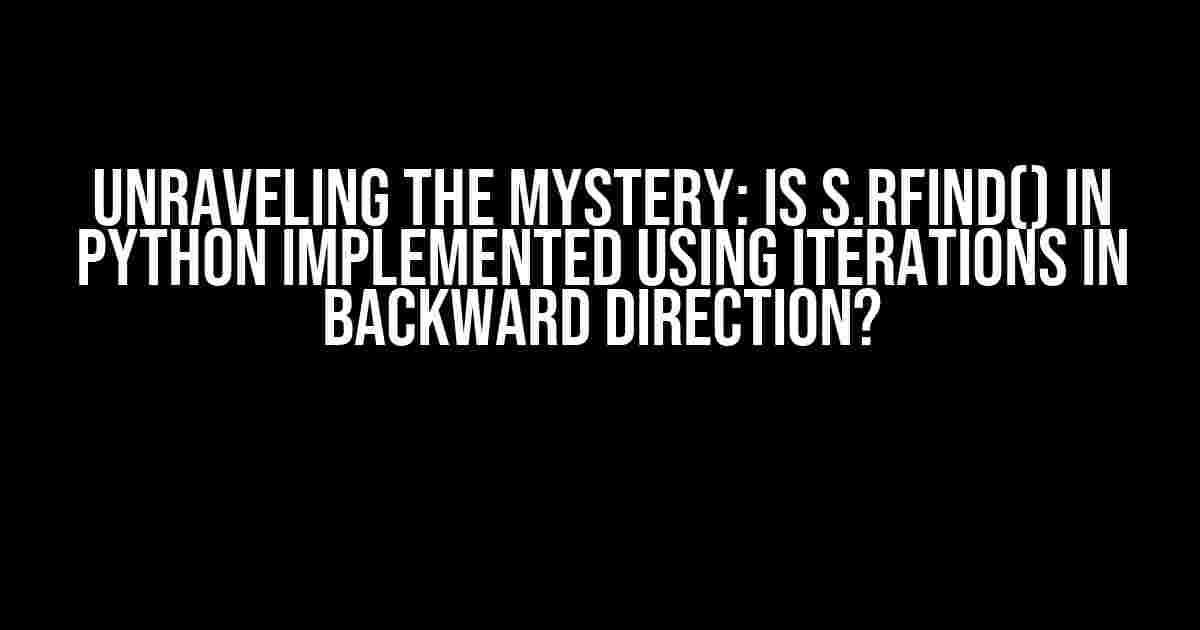Welcome to the world of Python, where the nuances of programming can sometimes leave us scratching our heads. One such enigma is the implementation of the s.rfind() method in Python. Have you ever wondered how this method manages to find the last occurrence of a substring in a string? Today, we’ll embark on a journey to uncover the truth behind s.rfind() and explore whether it’s indeed implemented using iterations in a backward direction.
The Mysterious Case of s.rfind()
When we use the s.rfind() method in Python, it returns the highest index of the substring in the string. But have you ever stopped to think about how it achieves this feat? The Python documentation is notoriously sparse, leaving us to rely on our own detective skills to unravel the mystery.
Lets start by examining the syntax of s.rfind():
s.rfind(sub[, start[, end]])In this syntax, s is the string we’re searching, sub is the substring we’re looking for, and start and end are optional parameters that specify the range of the search.
Theories and Speculations
So, how does s.rfind() work its magic? There are several theories floating around, but one prevailing notion is that it uses iterations in a backward direction. This theory suggests that the method starts from the end of the string and moves backwards, checking each character until it finds a match. But is this theory grounded in reality?
To get to the bottom of this mystery, let’s take a closer look at the Python source code. After digging through the CPython implementation, we can find the answer in the stringobject.c file:
static PyObject *
string_rfind(PyStringObject *self, PyObject *args)
{
PyObject *subobj;
Py_ssize_t start, end;
Py_ssize_t len, sublen;
char *str, *sub;
Py_ssize_t i;
/* Parse args */
if (!PyArg_ParseTuple(args, "O|nn", &subobj, &start, &end))
return NULL;
/* Get the string and substring */
str = PyString_AsString(self);
sub = PyString_AsString(subobj);
len = PyString_GET_SIZE(self);
sublen = PyString_GET_SIZE(subobj);
/* Calculate the start and end indices */
if (start < 0)
start = 0;
if (end > len)
end = len;
/* Iterate backwards to find the substring */
for (i = end - sublen; i >= start; i--) {
if (str[i] == sub[0] && memcmp(str + i, sub, sublen) == 0) {
return PyLong_FromSsize_t(i);
}
}
/* Return -1 if the substring is not found */
return PyLong_FromSsize_t(-1);
}Aha! The implementation of s.rfind() indeed uses iterations in a backward direction. The loop starts from the end of the string and moves backwards, checking each character until it finds a match. But how does it work its way backwards?
Unraveling the Backward Iteration
Let’s take a closer look at the loop that drives the s.rfind() method:
for (i = end - sublen; i >= start; i--) {
if (str[i] == sub[0] && memcmp(str + i, sub, sublen) == 0) {
return PyLong_FromSsize_t(i);
}
}The loop uses a simple yet elegant approach to iterate backwards. Here’s a step-by-step breakdown of how it works:
- The loop initializes the variable
itoend - sublen, which is the starting point of the search. This ensures that we don’t go beyond the range specified by the user. - The loop decrements
iby 1 in each iteration, effectively moving backwards through the string. - The conditional statement
if (str[i] == sub[0] && memcmp(str + i, sub, sublen) == 0)checks if the current character matches the first character of the substring, and if the remaining characters match the substring usingmemcmp. - If the condition is true, the method returns the index
i, which is the highest index of the substring in the string. - If the condition is false, the loop continues until it reaches the starting point
start. - If the loop reaches the starting point without finding a match, it returns -1 to indicate that the substring is not found.
Performance and Efficiency
One might wonder about the performance implications of iterating backwards through the string. Fortunately, the implementation of s.rfind() is highly efficient, thanks to the following reasons:
- The loop only iterates over the range specified by the user, which reduces the number of iterations.
- The use of
memcmpallows the method to quickly compare the remaining characters of the substring, reducing the number of comparisons. - The method returns as soon as it finds a match, which minimizes the number of iterations.
Conclusion
In conclusion, our investigation has revealed that the s.rfind() method in Python is indeed implemented using iterations in a backward direction. By examining the source code and analyzing the loop, we’ve gained a deeper understanding of how this method works its magic.
Understanding the implementation of s.rfind() can help us appreciate the beauty of Python’s string manipulation capabilities. By leveraging this knowledge, we can write more efficient and effective code that takes advantage of Python’s built-in functionality.
Final Thoughts
As we conclude our journey, we’re left with a sense of awe and admiration for the Python developers who crafted this elegant implementation. The next time you use s.rfind() in your code, remember the intricate dance of backward iterations that makes it all possible.
So, the next time you’re faced with a mysterious implementation in Python, don’t be afraid to dive into the source code and unravel the mystery for yourself. Who knows what secrets you might uncover?
Frequently Asked Question
Get ready to dive into the world of Python and uncover the secrets of the s.rfind() function!
Is s.rfind() in Python implemented using iterations in backward direction?
Yes, that’s correct! The s.rfind() function in Python is indeed implemented using iterations in the backward direction. It starts searching from the end of the string and moves towards the beginning. This is why it returns the highest index of the substring if it is found, and -1 if not.
What is the time complexity of the s.rfind() function in Python?
The time complexity of the s.rfind() function in Python is O(n), where n is the length of the string. This is because in the worst-case scenario, the function has to iterate through the entire string to find the substring or determine that it’s not present.
Can I use s.rfind() to find the index of a substring from the beginning of the string?
No, you can’t use s.rfind() to find the index of a substring from the beginning of the string. As mentioned earlier, s.rfind() searches from the end of the string and moves towards the beginning. If you want to find the index of a substring from the beginning, you should use the s.find() function instead.
What happens if the substring is not found using s.rfind()?
If the substring is not found using s.rfind(), the function returns -1. This is a convenient way to check if the substring is present in the string or not.
Can I use s.rfind() to find the last occurrence of a character in a string?
Yes, you can use s.rfind() to find the last occurrence of a character in a string. Simply pass the character as the argument to the function, and it will return the highest index of that character in the string. If the character is not found, it will return -1.




